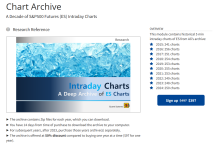Chart Archive-A Decade of S&P500 Futures (ES) Intraday Charts

Format
File Format- All files are graphical (image) .PNG file type
- The archive is organized base don year
- To view charts, download the Zip file on your computer and unzip the folder
- Size: Most files are about 1920 x 973 pixels
- Each file is made up of 3 charts. Most of the archive has a small daily chart and a 60 minute intraday chart along with a large five minute chart
- Friday chart includes a small weekly chart
- The last day of the month includes a small monthly chart
- The chart below shows how most charts in the archive is organized
- Later charts include an opening gap measurement indicator as you see on this chart
YYYYMMDD_Symbol - Gap - Day Structure - Day Type
Example:
20210115_ES - 20 pt Gap Dn Open - ORV Dn, PW LOD Rev, SC BL Trend, WBRF, DT LH MTR Dn - TTRD
- All files are named according to the above convention
- File names start with date (Year Month Day)
- Followed by symbol, which is ES for all charts in the archive
- If the day has a gap on the open, gap size is mentioned as points and in later years as percentage of the average daily range
- Price structures that build the day's chart are mentioned next, in the order they appeared
- File name ends with the day type. For example, a TTRD is a Trending Trading Range Day, which is a type of a trading range day that also trends some of the time
- The very first acronyms after gap size explain the type of the opening range
- Opening range (OR) or the first hour is the initial price action of the day that can last anywhere between less than an hour to more than two hours
- Most days (about 80% of them) have at least one reversal in the first hour and therefore form a trading range on the open
- If this range is broken out of, the OR type is ORBO for opening range breakout
- If the day forms a triangle for example, on the open followed by a breakout, it will be a TRI ORBO
- When there is only one reversal during the OR, it is called ORV up or down (for Opening Range reVersal)
- If the day trends from the first bar, the day is a T1B (Trend from 1st Bar) bull or bear
- Generally speaking, there are only three types of OR: T1B, ORV, and ORBO
- TRD: Trading Range Day
- TTRD: Trending Trading Range Day
- SPB: Small PullBack trend
- Trend: Bull (BL) or Bear (BR) trend all day
- FOMC: FOMC Report or Minutes announced
- TRI: Triangle
- ET: Expanding Triangle
